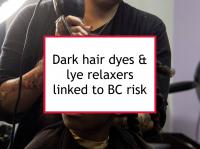Some studies have found evidence of increased breast cancer risk among women who use hair dye, especially dark hair dyes. For example, a large 2015 Finnish study reported that women who used hair dyes had a 23% higher risk of breast cancer than those who did not. Hair relaxers are less well studied.
A 2007 study using data from Boston University's Black Women's Health Study found no increased risk of breast cancer associated with hair relaxer use, although researchers did find a link to increased risk of uterine fibroids. However, now a new study has reported that lye-based hair relaxers are associated with increased risk of breast cancer in both African American and European-American women.
Latest research finds link between hair dyes, lye relaxers and BC
The study referenced above was designed to investigate the associations between hair product use and breast cancer risk, also comparing outcomes for African American (AA) and European-American (white) women by estrogen receptor (ER) and triple negative status. The study included women in the Women's Circle of Health Study (WCHS), a case-control study based in New York and New Jersey. Data was collected using in-person interviews and measurements of anthropometric and body composition variables. In addition, pathology records were reviewed. Participants were asked about their use of hair dyes, chemical relaxers, and cholesterol- and/or placenta-containing conditioning creams when they joined the study. The analyses were controlled for age, ethnicity, level of education, family history of breast cancer, oral contraceptive use, and body mass index (BMI).
The study included 4,285 women with breast cancer, of whom 2,798 were AA and 1,487 were white, as well as a set of matched cancer-free controls. A total of 30.2% of the AA controls and 57.8% of the white controls regularly used hair dye. Use of darker hair dye shades (dark brown, black) was found to be associated with 1.6 times the risk of breast cancer compared to use of light shades (blonde, light brown) among AA women. However, the authors did not find a dose response association — in other words, breast cancer risk did not appears to increase with increased frequency of dark hair dye use. No association was found between hair dye use and breast cancer risk among white women.
AA women were far more likely to use relaxers than white women (87.1% vs. 4.6% among the controls). AA women who used relaxers incorporating lye had 1.5 times the risk of breast cancer as AA women who used chemical relaxers without lye. Among white women, the risk of breast cancer was 1.7 times higher for those who used non-lye containing relaxers compared to never users and 4.4 times higher for those who used lye-based relaxers compared to never users. No associations were found between use of deep conditioning creams containing cholesterol or placenta and breast cancer risk.
Regular hair dye use, use of darker hair dye shades, and use of lye-based relaxers all were associated with increased risk of ER+ breast cancer, as was regularly using both hair dyes and relaxers. Regular use of hair dye was not found to be associated with increased risk of ER- or triple negative breast cancer. The authors conclude that there is a relationship between use of hair dyes and chemical relaxers and risk of breast cancer.
Please see our article on African American women for more information.
